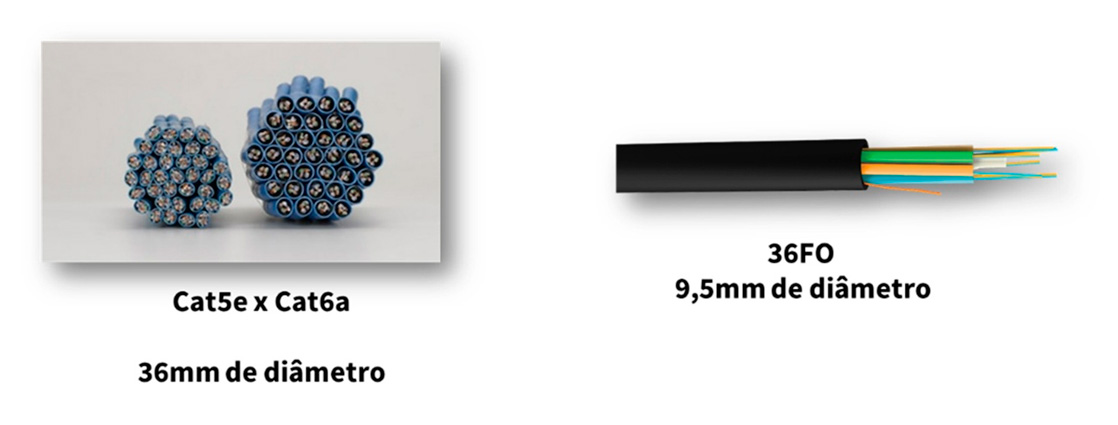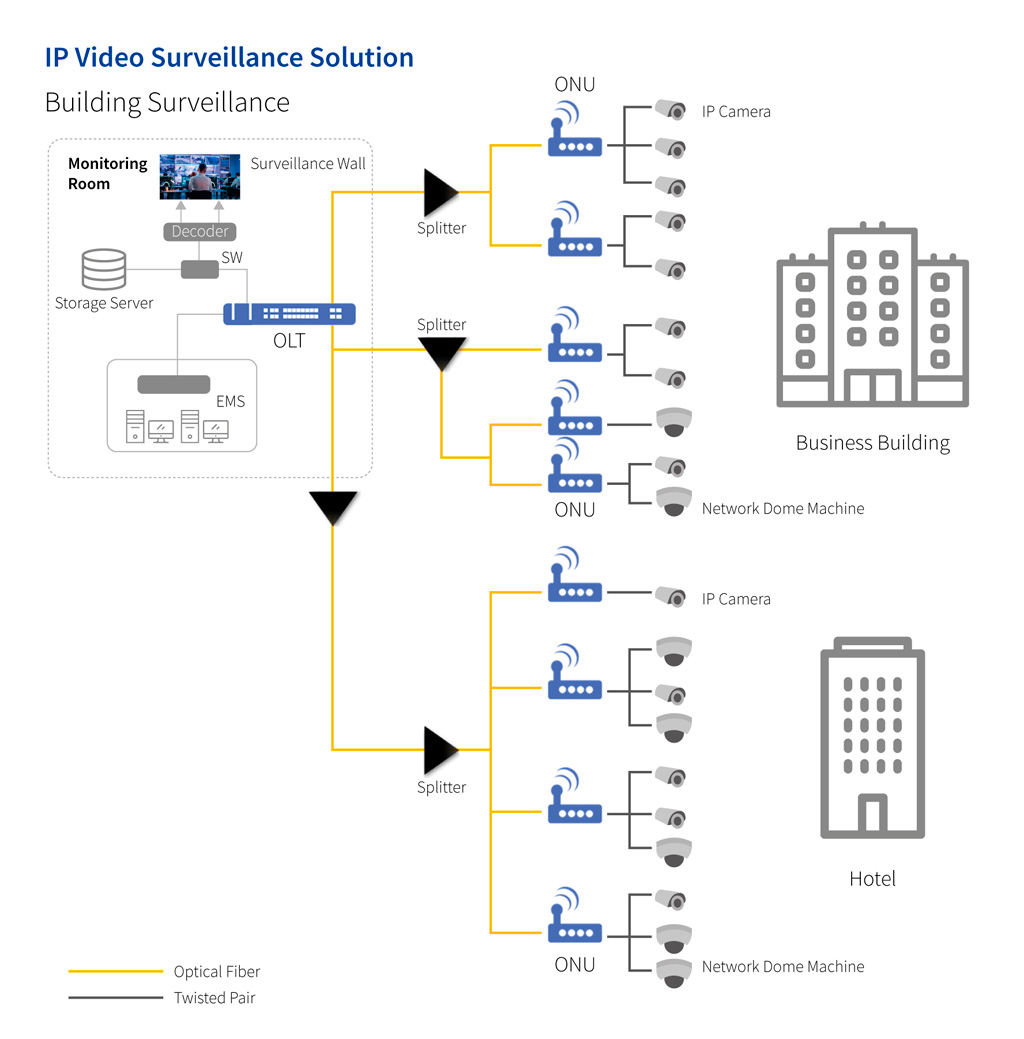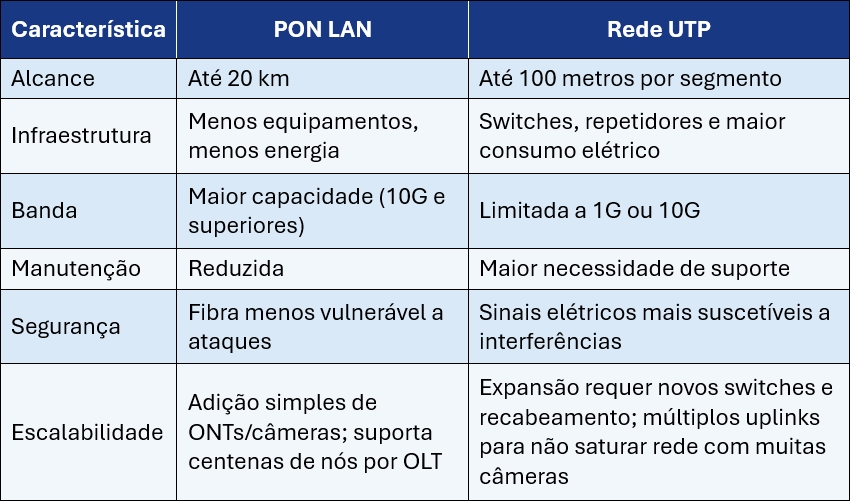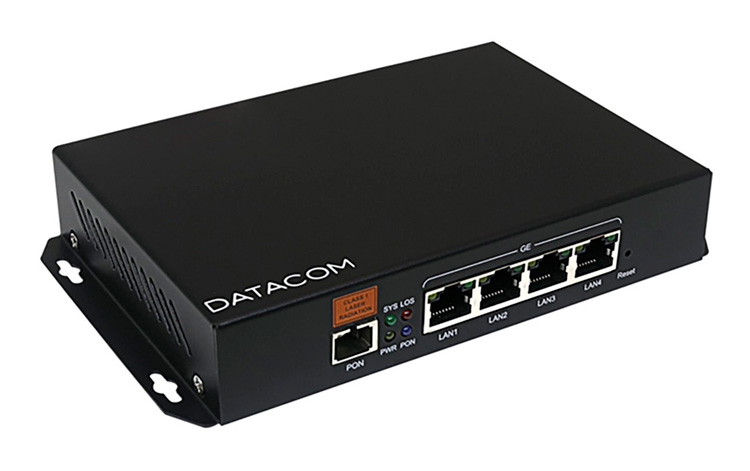CCTV and PON LAN: Efficiency and Cost Reduction in Electronic Security
Traditional CCTV networks face limitations such as short-range cables, the need for many switches, and high power consumption. PON LAN emerges as an alternative, eliminating much of this infrastructure and making projects more efficient.
The evolution of electronic security has driven the adoption of increasingly robust and scalable connectivity solutions. PON LAN has emerged as an efficient alternative for CCTV (Closed Circuit TV) networks, ensuring greater transmission capacity, reduced operating costs and less need for physical infrastructure.
Why use PON LAN in CCTV projects?
Traditional CCTV network architecture often uses copper cabling (UTP), requiring switches, repeaters and distributed racks to cover large distances. This generates high costs for infrastructure, maintenance and energy consumption. PON LAN, on the other hand, allows these structures to be replaced by a passive network based on optical fiber, significantly reducing investments and optimizing network performance.
Main advantages of PON LAN for CCTV:
- Less active equipment: Elimination of intermediate switches reduces acquisition, maintenance and energy consumption costs.
- Simplified infrastructure: Optical fiber allows connections of up to 20 km without significant signal loss, eliminating the need for repeaters and ensuring flexibility for large-scale projects.
- High reliability and security: Optical networks are immune to electromagnetic interference and have native encryption, making it difficult to intercept data.
- Scalability: The topology allows for easy expansion, simply by adding new ONTs and cameras to the existing structure.
- Reduced operating costs: Fewer active devices result in lower energy consumption, less need for cooling, and less maintenance over time.


Infrastructure Reduction Example
PON LAN Network Topology for CCTV
The PON LAN infrastructure for CCTV can be structured as follows:
- OLT - Optical Line Terminal: Located in the data center or control room, the OLT is the central equipment of the network. It manages all optical communication, distributing traffic to splitters and ONTs. In addition, it enables bandwidth control, service prioritization and specific configurations for different usage profiles.
- Optical Splitter: Passive element of the network, responsible for dividing the optical signal sent by the OLT to multiple ONTs. This division can be done in different proportions, such as 1:2, 1:4, 1:8, 1:16 and even 1:64, allowing the infrastructure to be adjusted according to the density of the installation. Since there is no need for electrical power, splitters reduce energy consumption and network failure points.
- ONTs - Optical Network Terminals: These act as end points of the PON network, converting the optical signal into electrical signal to power the network devices. In the context of CCTV, ONTs often include Ethernet ports with support for PoE (Power over Ethernet), allowing direct connection of IP cameras without the need for PoE injectors or additional switches. Models such as the Datacom DM986-400P, for example, offer PoE+ ports capable of supplying power and data simultaneously to multiple cameras.
- IP Cameras: End devices of the network responsible for capturing, processing and transmitting video. By using PON LAN, it is possible to ensure a stable and high-capacity connection, allowing transmissions in Full HD, 4K and even future 8K applications. In addition, the use of PoE eliminates the need for dedicated power supplies, simplifying installation and reducing operating costs.


This approach allows for a more simplified, scalable and easy-to-maintain infrastructure, making it ideal for projects that require high reliability, such as condominiums, commercial buildings, industrial plants and government applications.
Comparison: PON LAN vs. Traditional Network (UTP)

Usage Scenarios and Market Potential
With the growing concern for security and the expansion of CCTV systems in various segments, PON LAN is consolidating itself as a viable solution for large-scale projects. Among the most common applications are:
- Residential condominiums: Monitoring systems are essential for the safety of residents, covering common areas, entrances, parking lots and restricted access. With fiber optics, the network can be structured more efficiently, reducing cabling costs and eliminating points of failure.
- Commercial buildings: Offices, shopping malls and business centers require continuous surveillance to ensure the protection of employees, customers and assets. PON LAN technology facilitates the distribution of security cameras on different floors without the need for multiple switches, in addition to providing greater reliability in image transmission.
- Industrial plants: Manufacturing environments have specific demands, such as monitoring risk areas, perimeter control and supervision of production processes. PON LAN allows covering large areas without signal loss, ensuring high-resolution images and reliable communication between security devices.
- Government projects: Critical infrastructures, such as urban, highway and airport monitoring, depend on high-capacity and high-availability networks. The optical topology ensures secure and long-range transmission, reducing vulnerabilities and facilitating integration with other public safety systems.
Datacom products for PON LAN networks in CCTV
Datacom offers a comprehensive portfolio for implementing PON LAN networks applied to CCTV, ensuring high-performance and reliable solutions.
- High-performance OLTs: Enable optimized signal distribution to a large number of ONTs, ensuring high network capacity and quality video transmission.
- ONUs such as the DM986-400P: Feature Ethernet ports with support for PoE (802.3af) and PoE+ (802.3at), allowing direct power supply to IP cameras without the need for external power sources.
- DmView: An integrated platform for monitoring and controlling infrastructure, enabling centralized configuration and management of connected devices.
- DM-SV Servers: Designed for high-processing applications, including facial recognition and AI-based video analysis. These servers can query online databases for identifying individuals or suspicious events, providing predictive analytics for advanced security.
- Large-scale storage: DM-SV servers can also be configured as storage units for high-resolution video recording, ensuring long-term retention and efficient retrieval of recorded footage.
With this range of solutions, Datacom provides a robust and scalable infrastructure, ensuring greater efficiency and security for CCTV projects over PON LAN.

Conclusion
The implementation of PON LAN networks for CCTV is a modern and cost-effective solution for electronic security projects. Its ability to reduce infrastructure, improve performance and offer greater operational security makes this technology ideal for integrators, resellers and companies seeking to optimize their monitoring systems. With a more efficient infrastructure, managers can reduce costs and increase the reliability of security networks, ensuring a scalable solution for the future.
If your company is looking for greater efficiency and security in CCTV networks, contact Datacom to learn more about our solutions.
